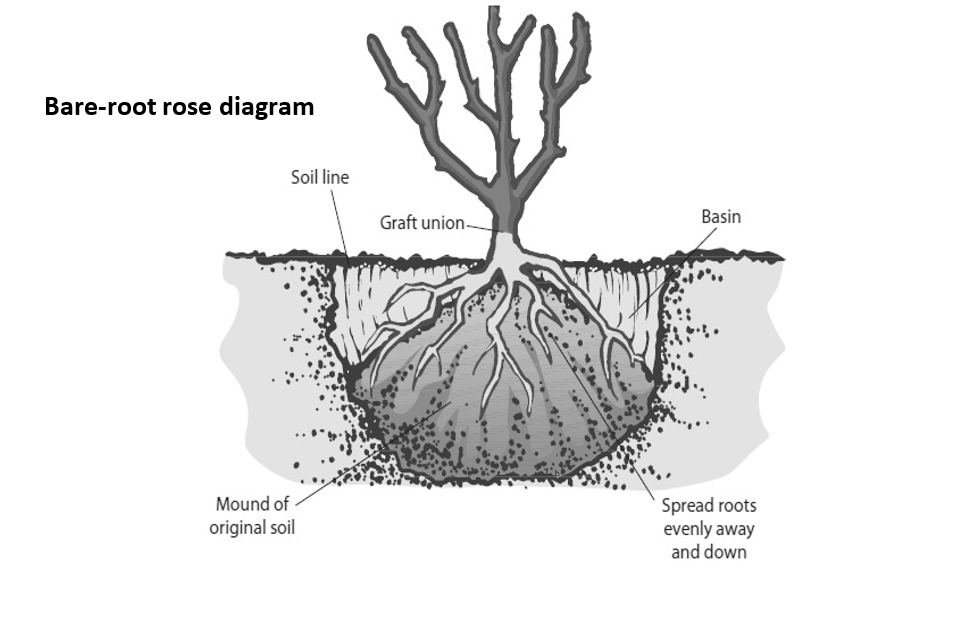How to Plant a Bare Root Rose
Planting a bare-root Rose is easy! There are just a few tricks you should know. These instructions should help. If you have any questions, stop by the nursery or give us a call!
- Remove your rose from the bag, and remove or loosen any tightly-wound tags or stem tapes. Carefully untangle the roots. Trim off any broken roots or branches. Soak the roots in plain, air-temperature water for 2 – 3 hours. Do not allow the roots to dry out, and make sure not to soak for more than 4 hours.
- Dig a short, wide hole. It should be as deep as the root zone plus the graft, and be at least twice as wide as the roots. The hole should be wide enough to allow the roots to spread out and to grow outward without crowding. If you dug the hole too deep, put some soil back in and firm it down with your foot to prevent settling.
- Using the excavated field soil, make a mound in the center of the hole, firming the soil as you create the mound to avoid settling. Place your plant atop the mound, spreading the roots out evenly down the sides of the mound. Take care that you are not planting too deeply. In the Pacific Northwest, it is not necessary for the knobby graft union is to be below ground level; in our wet climate this can lead to rot. Position the graft knot/crown right at ground level.
- Sprinkle a mycorrhizae inoculant over the roots.
- Fill the bottom half of the hole with the existing field soil you excavated when you dug the hole. Gently tamp it down.
- Generously amend the remaining backfill soil with compost or aged manure, aiming for a one-third amount of compost to field soil. Fill the rest of the hole with this amended soil, again tamping as you go. It should be firmly but not tightly packed. Water generously to help settle the soil around the roots and into the hole. If you notice that your plant is sinking as the soil settles, it is important to gently wiggle and adjust your Rose, according to the guidance above.
- After the water has soaked in, spread a protective mulch 2-3 inches deep in a 3-foot diameter area around the base. Leave a 4-inch circle around the base of the plant, so the mulch never touches the trunk. We recommend our Soil Building Conditioner as a mulch.
- Protect from deer. Make a “cage” around the rose by inserting 3 evenly-spaced stakes around the plant (ideally 48” tall). Wrap a length of field fence in a circle, securing it to the stakes. Or use the stakes as a framework, and wind wire or fishing line around them. Take care that no wire or plastic is touching or wrapped around the rose. Ensure the fencing is tall enough that deer cannot stick their heads over the fence for a snack of tasty rose shoots. Additionally, it is a great idea to keep newly planted plants well-sprayed with deer repellant sprays – it can help to make a bad first impression with the deer!
- Throughout the growing season, give your new rose plenty of water. Deep watering is recommended to help your plant develop a deep root system. Leave the hose on a trickle for 30 minutes or so, making sure that water is soaking the entire root zone. It can be helpful to set a reminder alarm on your cell phone! The goal is to keep the soil moist but not soggy and to allow the soil to drain well between waterings. If you have a spray irrigation system, DO NOT rely on it to provide adequate, deep waterings.
- Once your rose has started to bud out, feed with an organic liquid fertilizer every 3 weeks. We recommend Fish Emulsion. New roses are sensitive to root burn from granular fertilizer, esp. non-organic types.

